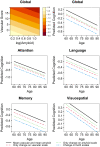White matter abnormalities are key components of cerebrovascular disease impacting cognitive decline
- PMID: 33937772
- PMCID: PMC8072521
- DOI: 10.1093/braincomms/fcab076
White matter abnormalities are key components of cerebrovascular disease impacting cognitive decline
Abstract
While cerebrovascular disease can be observed in vivo using MRI, the multiplicity and heterogeneity in the mechanisms of cerebrovascular damage impede accounting for these measures in ageing and dementia studies. Our primary goal was to investigate the key sources of variability across MRI markers of cerebrovascular disease and evaluate their impact in comparison to amyloidosis on cognitive decline in a population-based sample. Our secondary goal was to evaluate the prognostic utility of a cerebrovascular summary measure from all markers. We included both visible lesions seen on MRI (white matter hyperintensities, cortical and subcortical infarctions, lobar and deep microbleeds) and early white matter damage due to systemic vascular health using diffusion changes in the genu of the corpus callosum. We identified 1089 individuals aged ≥60 years with concurrent amyloid-PET and MRI scans from the population-based Mayo Clinic Study of Aging. We divided these into discovery and validation datasets. Using the discovery dataset, we conducted principal component analyses and ascertained the main sources of variability in cerebrovascular disease markers. Using linear regression and mixed effect models, we evaluated the utility of these principal components and combinations of these components for the prediction of cognitive performance along with amyloidosis. Our main findings were (i) there were three primary sources of variability among the CVD measures-white matter changes are driven by white matter hyperintensities and diffusion changes; number of microbleeds (lobar and deep); and number of infarctions (cortical and subcortical); (ii) Components of white matter changes and microbleeds but not infarctions significantly predicted cognition trajectories in all domains with greater contributions from white matter; and (iii) The summary vascular score explained 3-5% of variability in baseline global cognition in comparison to 3-6% variability explained by amyloidosis. Across all cognitive domains, the vascular summary score had the least impact on memory performance (∼1%). Though there is mechanistic heterogeneity in the cerebrovascular disease markers measured on MRI, these changes can be grouped into three components and together explain variability in cognitive performance equivalent to the impact of amyloidosis on cognition. White matter changes represent dynamic ongoing damage, predicts future cognitive decline across all domains and diffusion measurements help capture white matter damage due to systemic vascular changes. Therefore, measuring and accounting for white matter changes using diffusion MRI and white matter hyperintensities along with microbleeds will allow us to capture vascular contributions to cognitive impairment and dementia.
Keywords: amyloidosis; cerebrovascular disease; diffusion MRI; microbleeds; white matter hyperintensities.
© The Author(s) (2021). Published by Oxford University Press on behalf of the Guarantors of Brain.
Figures






References
-
- Schneider JA, Arvanitakis Z, Bang W, Bennett DA.. Mixed brain pathologies account for most dementia cases in community-dwelling older persons. Neurology. 2007;69(24):2197–2204. - PubMed
-
- Wardlaw JM, Smith C, Dichgans M.. Small vessel disease: Mechanisms and clinical implications. Lancet Neurol. 2019;18(7):684–696. - PubMed
-
- Frantellizzi V, Pani A, Ricci M, Locuratolo N, Fattapposta F, De Vincentis G.. Neuroimaging in vascular cognitive impairment and dementia: A systematic review. J Alzheimers Dis. 2020;73(4):1279–1294. - PubMed
Grants and funding
LinkOut - more resources
Full Text Sources
Other Literature Sources
